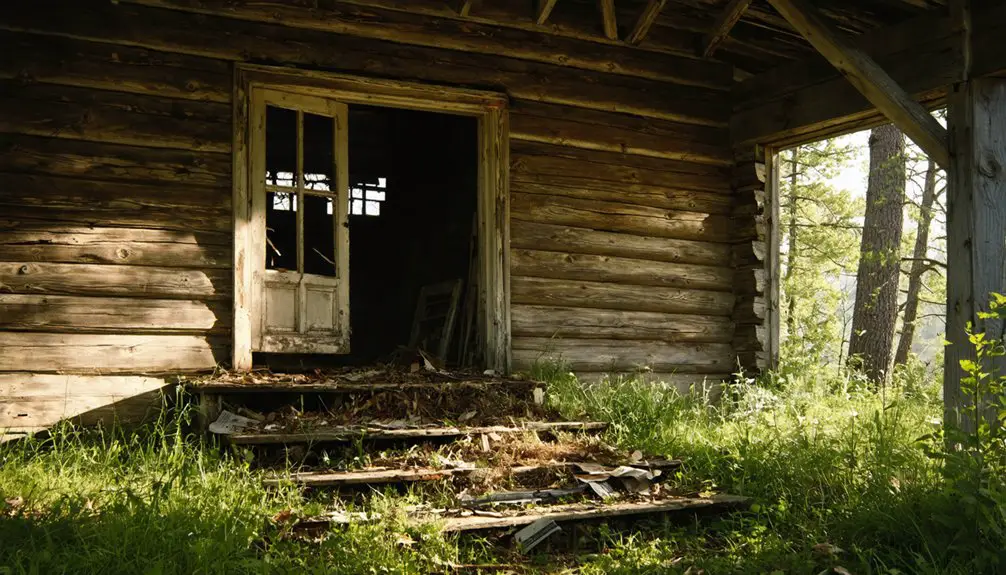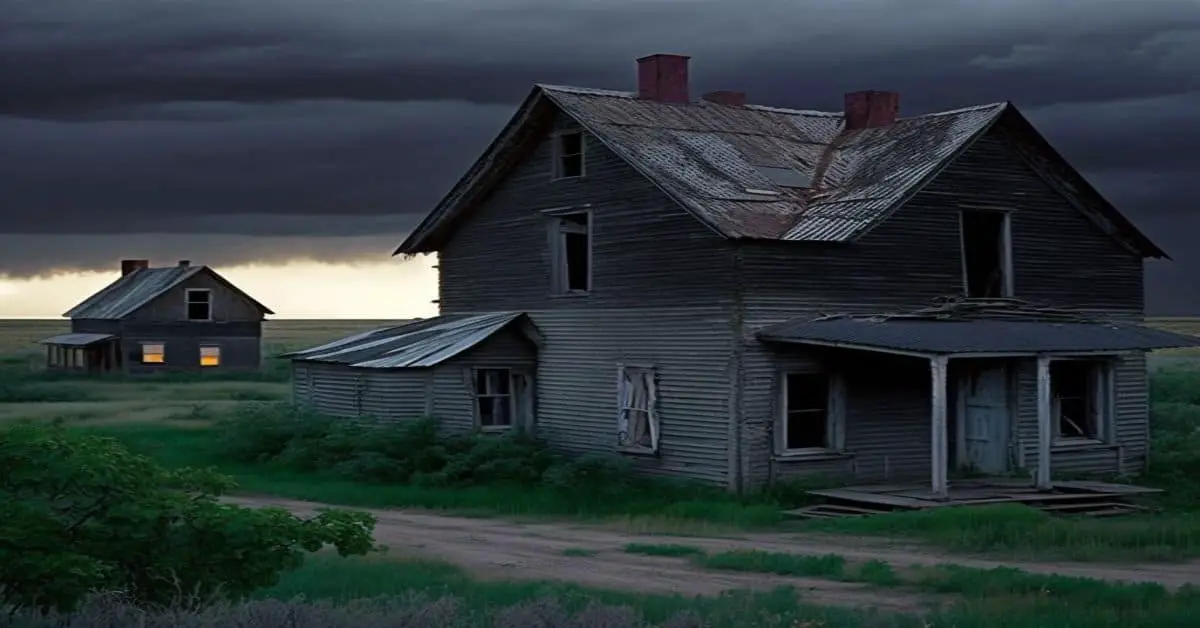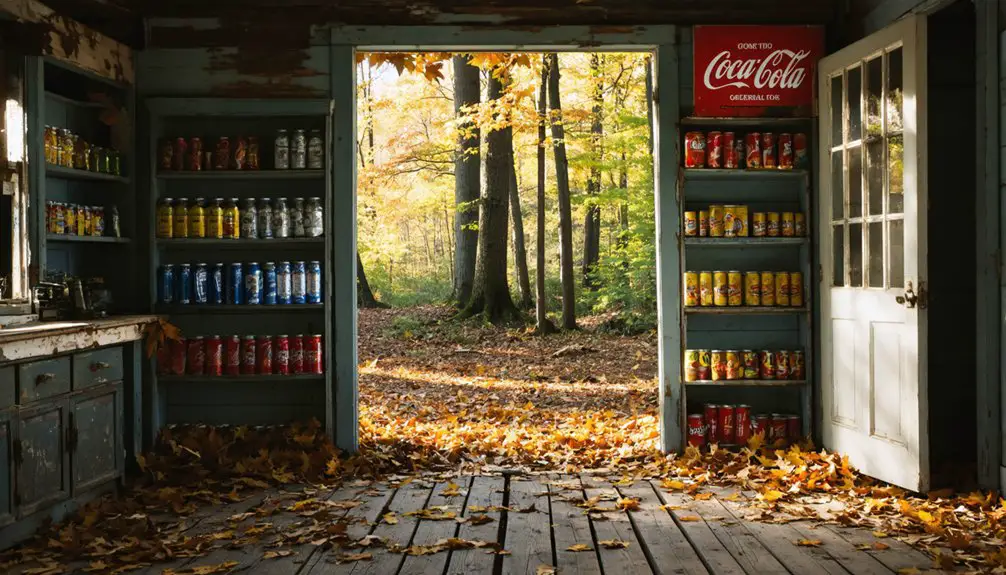You’ll find Flagstaff, Maine’s history beneath the waters of Flagstaff Lake, where an entire township was intentionally submerged in the 1950s for a hydroelectric project. The town, named after Benedict Arnold’s military marker during his 1775 expedition, once thrived as a logging community 48 miles northwest of Skowhegan. Today, guided tours explore the underwater ghost town‘s remnants, while local historical societies preserve the compelling stories of displaced residents and their lost community.
Key Takeaways
- Flagstaff, Maine became a ghost town when it was intentionally flooded in the 1950s to create Flagstaff Lake for hydroelectric power.
- The town, named after Benedict Arnold’s military marker, now lies submerged beneath 20,300 acres of water.
- Residents were forced to relocate in 1930 after Central Maine Power acquired the land for the hydroelectric project.
- Underwater remnants of the town, including building foundations and flooded forests, can still be explored through guided tours.
- The submerged town’s history is preserved through historical societies, photographs, maps, and seasonal recreational activities around Flagstaff Lake.
The Birth of a Maine Township
Three key factors shaped Flagstaff’s early development as a Maine township in the 1800s: its abundant timber resources, the fertile soil of the Dead River floodplain, and the natural Flagstaff Pond’s hydropower potential.
The natural resources of timber, rich floodplain soil, and hydropower from Flagstaff Pond drove Maine’s early Flagstaff township development.
You’ll find this settlement nestled 48 miles northwest of Skowhegan, surrounded by hills and the impressive 3,300-foot Mount Bigelow to the south. The area’s good interval land along Dead River proved ideal for hay production.
The timber economy quickly became the backbone of Flagstaff’s growth after permanent settlers arrived in the early 1800s. The township’s rich woodlands supported extensive logging operations by 1865. Later, Central Maine Power would acquire the area’s power companies, forever changing the region’s destiny.
Town governance officially began with Flagstaff Plantation’s organization on March 5, 1895, following earlier electoral organizations in 1851, 1865, and 1870. The community thrived through annual town meetings and established itself as a transport junction on the North Anson to Eustis stage line.
Benedict Arnold’s Legacy and Town Naming
While Benedict Arnold‘s name would later become synonymous with treason, his 1775 expedition through Maine’s wilderness left an indelible mark on Flagstaff’s identity.
You’ll find Arnold’s contributions immortalized in the naming of this region, where he ordered a flagstaff raised as a military marker during his ambitious march to Quebec.
Despite leading 1,100 Continental troops through treacherous terrain and devastating weather conditions near present-day Flagstaff Lake, his historical significance endures. Only twenty original bateaux survived the grueling journey from the initial fleet of 220 boats.
The Arnold Trail to Quebec, now listed in the National Register of Historic Places, preserves this legacy.
You can still hike the path where Arnold’s expedition battled nature’s fury, and though the town now lies beneath Flagstaff Lake’s waters, its Revolutionary War heritage lives on through annual commemorations.
Today, visitors can explore the 20,300-acre lake, Maine’s largest man-made freshwater body, which submerged the historic town in 1950.
Early Settlers and Industrial Growth
A wave of pioneering settlers arrived in Flagstaff during the early 1800s, drawn by the fertile soil of the Dead River floodplain and the region’s rich timber resources.
You’ll find that these early pioneers, including the Viles family and William Butler, established themselves as lumbermen, rivermen, and guides, laying the foundation for the area’s logging economy. The location proved challenging to document historically, as many place names required careful disambiguation due to similar settlements in the region.
The settlers thrived in a close-knit atmosphere where residents regarded themselves as one big family, supporting each other through the challenges of frontier life.
The Decision to Build Flagstaff Lake
During the 1920s, legislative approval set in motion a transformative hydroelectric project that would forever alter Maine’s Dead River Valley.
The initial plan called for building at The Forks, where the Dead River meets the Kennebec, but legislative opposition from Percival Baxter influenced the ultimate dam site decision.
You’ll find that Central Maine Power‘s strategy shifted when faced with costly lease requirements for state-owned lands.
Instead of proceeding at The Forks, they opted to construct at Long Falls on the Dead River.
This pivotal decision in the late 1920s would lead to the creation of Flagstaff Lake, setting the stage for massive land acquisitions beginning in 1930 and the eventual submersion of entire communities beneath its waters.
Forced Exodus: A Community Displaced
Once Central Maine Power finalized its plans for Flagstaff Lake in 1930, residents of the Dead River Valley faced an unprecedented forced relocation that would tear apart their tight-knit community.
You’ll find stories of deep sadness as teachers, store owners, and multi-generational families were uprooted from their lifelong homes. The emotional toll wasn’t just about losing property – it meant disrupted education, fractured social networks, and uncertainty about the future. The schoolhouse was one of the few buildings that survived after being moved to safety.
Despite the overwhelming display of state and corporate power, community resilience shone through. Some families managed to physically move their houses to higher ground, while others worked to preserve memories of their lost town. The Dead River Road closed as flooding began, marking the final chapter for many residents.
Even the difficult task of relocating ancestors’ remains from local cemeteries became a poignant symbol of their determination to honor their heritage.
The Final Days Before Submersion
In the final days before Flagstaff’s submersion, you’d have witnessed a haunting landscape of tree stumps and scorched earth as crews systematically cleared the future lakebed.
You’d have seen former residents dismantling their homes and businesses, with some opting to physically relocate entire structures while others left their properties to the flood waters. The Central Maine Power Company bought out the residents’ properties to make way for their hydroelectric dam project.
Through July 1949, you’d have observed the methodical erasure of the town – from the razing of buildings to the relocation of the schoolhouse – leaving only memories of what once stood in this Maine community. Approximately 300 residents gathered for one final meeting to bid farewell to their beloved village before the waters rose.
Clearing the Town Away
After Central Maine Power Company secured the necessary approvals in 1948, crews began the systematic dismantling of Flagstaff’s physical presence in preparation for the dam project.
You’d have witnessed teams conducting extensive land clearing operations throughout 1948 and 1949, removing trees, brush, and structures that once defined this logging community.
The town’s essential infrastructure was methodically decommissioned as workers tore down sawmills, gristmills, and farmhouses.
Some residents salvaged building materials before departure, while others left their properties intact.
Controlled burns and mechanical clearing aided in debris removal, ensuring the future lake bed would be free of hazards.
Roads were rerouted, utility lines were disconnected, and the valley that had sustained generations of loggers and farmers was stripped bare.
Personal Belongings Left Behind
The final days of Flagstaff witnessed a painful separation between residents and their cherished belongings as the 1950 deadline approached. You’d find abandoned belongings scattered throughout homes as residents faced impossible choices about what they could take.
Furniture, clothing, and household items were often left behind when transportation proved limited.
The emotional legacy of this forced exodus ran deep, as families had to part with items tied to generations of memories. While larger structures like the schoolhouse were preserved, personal artifacts from homes, churches, and local businesses met their fate beneath Flagstaff Lake’s waters.
Even gravesites weren’t spared, as remains were exhumed and relocated, severing yet another connection to the town’s heritage. Some families managed to keep mementos, passing down tangible pieces of their submerged hometown.
Life Beneath the Waters Today
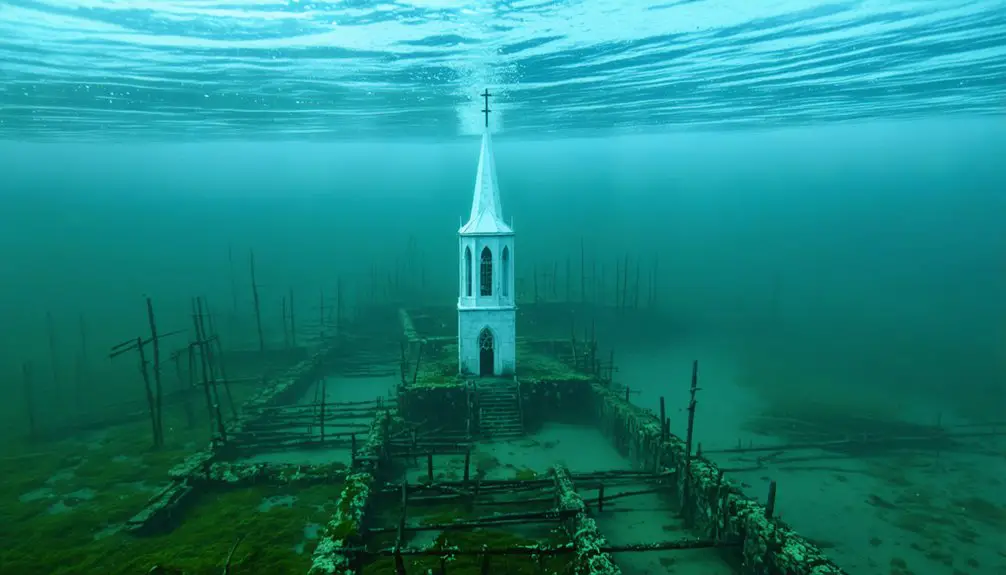
Beneath Flagstaff Lake’s surface lies a complex aquatic ecosystem that has evolved since the 1950s flooding of the original village.
Time and water transformed Flagstaff village into an underwater world where nature reclaimed what humans left behind.
You’ll find remnants of the old town‘s structures intermingled with established aquatic habitats, creating a unique underwater landscape where native fish species now thrive among the ghostly remnants of human civilization.
The lake’s underwater archaeology tells a compelling story, with sediment-covered foundations and flooded forests marking where people once lived and worked.
Today, you’ll see this transformed environment carefully managed to balance recreation with preservation.
While detailed studies remain limited, the submerged townsite continues to intrigue researchers and locals alike.
The lake’s waters now serve multiple purposes – from supporting recreational activities to providing essential wildlife habitat, all while preserving a piece of Maine’s history.
Cultural Impact and Local Memory
- The relocated schoolhouse serves as a tangible connection to Flagstaff’s educational heritage.
- Local historical societies maintain extensive archives of photographs and maps.
- PBS programs and radio documentaries share the town’s story with wider audiences.
- Ghost town tourism and exploration keep the community’s spirit alive.
- Take a guided boat tour from May through September to learn about submerged villages while spotting wildlife like eagles, hawks, and even mountain lions.
- Launch your kayak or canoe from multiple access points for day trips or multi-day expeditions along undeveloped shorelines.
- Combine backpacking along the Appalachian Trail with lakeside camping, carrying your gear through the rugged Bigelow Mountains.
- Experience world-class wildlife watching opportunities in pristine habitats, where moose and various bird species thrive in their natural environment.
- Set up your tent or RV at sites equipped with amenities like restrooms and fire pits
- Access prime spots for fishing, boating, and kayaking directly from your campsite
- Explore hiking trails through surrounding forests while learning about the submerged town’s history
- Take advantage of local outfitters and visitor centers for maps, permits, and guided tours
- https://wjbq.com/ghost-town-legendary-sacrifice-flagstaff-maine/
- https://en.wikipedia.org/wiki/Flagstaff
- https://www.mainesnorthwesternmountains.com/things-to-do/sight-seeing-scenic-drives/the-valley-below
- https://wcyy.com/maine-underwater-ghost-town-flagstaff-lake/
- http://thedeadriver.com/the-history-of-flagstaff-village/
- https://maineanencyclopedia.com/flagstaff-township/
- https://townline.org/solon-beyond-the-burial-of-flagstaff-story-continues/
- https://92moose.fm/flagstaff-maine-maines-ghost-town-video/
- https://www.pressherald.com/2014/10/05/benedict-arnold-trail-opening/
- https://www.themainemag.com/2865-flagstaff-stories-afloat/
This transformation from thriving town to submerged settlement exemplifies Maine’s complex relationship with progress and preservation, forever etched in regional consciousness.
Environmental Transformation
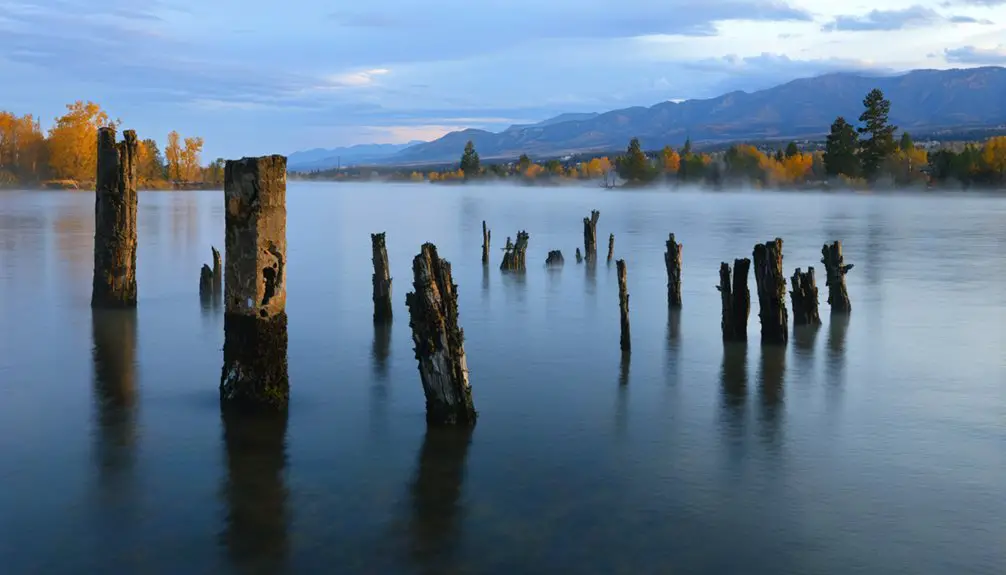
Beyond the human stories and cultural memories lies a profound physical transformation of Maine’s Dead River Valley.
When you visit Flagstaff Lake today, you’re witnessing the result of flooding 20,300 acres in the 1950s, converting a vibrant river ecosystem into Maine’s fourth-largest lake. The environmental adaptation has been dramatic – where forests once stood and farms flourished, you’ll now find a shallow reservoir teeming with different forms of life.
A dramatic transformation turned Maine’s Dead River Valley into Flagstaff Lake, forever altering the landscape from farmland to reservoir waters.
The flooding reshaped the region’s ecology, altering everything from water flow patterns to local microclimates. While some species have adapted to the new aquatic environment, others disappeared with the original river valley.
Today’s ecological restoration efforts focus on balancing hydroelectric needs with preserving what remains of the natural landscape, as submerged forests and farmlands continue influencing the lake’s ecosystem.
Modern Recreation and Historical Tourism
You’ll find Flagstaff Lake buzzing with boaters, anglers, and water sports enthusiasts during peak seasons, while the surrounding wilderness offers numerous camping spots for overnight stays.
The lake’s fascinating history draws visitors interested in exploring the submerged ghost town through guided tours and interpretive signs that detail the community’s forced relocation in 1950.
Local historical societies and museums enhance your experience by providing photographs, maps, and artifacts from the former town, making it a unique destination that combines outdoor recreation with historical exploration.
Popular Lake Activities
While Flagstaff Lake stands as Maine’s fourth-largest body of water, its pristine shoreline and mountain backdrop create an ideal setting for diverse recreational activities.
You’ll discover countless water activities and outdoor adventures that connect you with both nature and history.
Historical Ghost Town Tours
The haunting story of Flagstaff’s submerged town draws visitors from across the country to explore its rich historical legacy.
You’ll discover engaging tours that blend ghost stories with authentic historical accounts of the town’s tragic flooding in 1950. Local historical societies offer guided experiences through the Dead River Valley, where you can visit the relocated schoolhouse and preserved grave sites while learning about the community’s forced relocation.
Along scenic drives, you’ll encounter informative markers and exhibits featuring historical maps and photographs of pre-flood Flagstaff.
These tours often incorporate historical reenactments that bring to life the dramatic events leading to the town’s submersion, including the controversial fires set to clear the land and the emotional displacement of residents beneath what’s now Flagstaff Lake.
Seasonal Camping Spots
Modern camping opportunities surround Flagstaff Lake, offering both recreational activities and a unique historical backdrop for outdoor enthusiasts.
You’ll find both established campgrounds and dispersed sites for seasonal camping, operating primarily during the warmer months from late spring through early fall.
For the best outdoor recreation experience, make reservations in advance, as these camping areas attract visitors seeking both natural adventures and historical exploration around the former town of Flagstaff.
Frequently Asked Questions
What Was the Average Compensation Paid to Displaced Flagstaff Residents?
You won’t find exact displacement compensation figures in public records, though resident support included property purchases, relocation assistance, and options to repurchase homes on higher ground from Central Maine Power.
Were Any Residents Known to Have Refused to Leave Their Homes?
Like a closed chapter in history, you won’t find any documented cases of residents refusing to leave. While resident stories and ghost sightings persist, historical records show everyone evacuated before the flooding.
How Deep Is Flagstaff Lake at Its Deepest Point?
You’ll find Flagstaff Lake’s maximum depth reaches 48-50 feet where the ghost town once stood. Despite varying reports, this depth range is consistently confirmed by Maine’s official surveys and fishing charts.
Can Divers Explore the Underwater Remains of the Original Town?
Imagine gliding through cold, dark waters – you can explore underwater remains up to 50 feet deep, where historical artifacts await. You’ll need proper permits and diving experience to safely navigate submerged structures.
What Wildlife Species Disappeared or Emerged After the Flooding?
You’ll find terrestrial mammals and birds vanished as forests flooded, while fish and waterfowl flourished. Wildlife adaptation led to species migration, with mammals moving upland and aquatic creatures colonizing the new lake environment.
